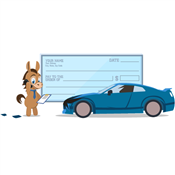Pay As You Go Insurance
Pay-as-you-go car insurance is gaining speed among drivers. But is it the right choice for you? Check out the pros and cons before deciding.
 |
- How Does Pay-as-You-Go Auto Insurance Work?
- How Do They Know When You're Driving?
- Advantages of Pay-as-You-Go Insurance
- Disadvantages of Pay-as-You-Go Insurance
- How Much Does Pay-as-You-Go Insurance Cost?
- Is Pay-as-You-Go Auto Insurance Right for Me?
- Which Insurance Companies Offer Pay-as-You-Go Car Insurance?
Thanks to technology, pay-as-you-go technology has become a great option for drivers who:
- Have a short commute
- Carpool
- Work from home
- Don't drive often or have low annual mileage
- Use public transportation to commute and drive their vehicles only on weekends.
- Have a multiple vehicle household where there are lesser-used vehicles
- Are new, young, or inexperienced drivers looking to lower their premiums
- Have antique cars that are not rarely driven.
Read on to see if this auto insurance option makes sense for you.
How Does Pay-as-You-Go Auto Insurance Work?
This type of auto insurance policy is based on actual vehicle usage. Your policy premium, or the amount you pay, is determined by how many miles you drive.
With traditional auto insurance, insurers base their rates on certain assumptions:
- Drivers drive an average of 12,000 miles per year.
- Most people drive during peak traffic hours, such as morning and evening rush hours.
- Most accidents happen during peak traffic hours.
Even if these assumptions don't match your driving behavior, you still pay for traditional car insurance as if they do. But with pay-as-you-go insurance, your rate changes month to month based on:
- The time of day when you drive
- How often you drive
- Your driving behavior. Some types of policies, good driving behavior is rewarded, such as driving within the speed limit, not braking suddenly, or not taking turns too fast.
Some insurance companies use a pay-as-you-go structure that includes a low base rate plus a per mile price. Premiums are paid on a monthly basis, rather than every six months or once a year.
How do they know when you're driving your vehicle?
Auto insurance companies can choose from three different ways to monitor your driving:
Certifying the odometer reading yearly
You provide your insurance company with a certified copy of your odometer reading each year. This qualifies you for the lower pleasure rate versus the higher commuter rate.
Installing a tracking device
This small box automatically collects data from the vehicle, which is then transmitted to the insurer. Data captured includes:
- Time of day
- Speed
- Distance or time traveled
- Driving actions
Using a built-in telematics system
These systems (OnStar® is one example) automatically report mileage. A GPS gathers the data and transmits it via radio frequency or cell phone.
Advantages of Pay-as-You-Go Insurance
Cost Savings
Your auto insurance premium is significantly less than that of traditional car insurance. This is particularly beneficial for new, young, or inexperienced drivers, since this group pays the highest premium due to the risk they pose.
Reduced Pollution
Driving less means cutting down on the harm done to the environment when you get behind the wheel.
Disadvantages of Pay-as-You-Go Insurance
Invasion of Privacy
Many people feel anxious knowing that a tracking device is following them. This type of insurance has a "Big Brother is watching you" feel.
Maximum Mileage Limit
The insurance company sets a limit to how much you can drive. If you go over this limit, you may be charged a penalty fee or pay a fee for every mile over the limit. This may mean paying more than you would for traditional auto insurance.
Changing Premiums
Some policies change the price from month to month depending on how many miles you drive. With this fluctuation, it might be hard sticking to your monthly insurance budget.
How Much Does Pay-as-You-Go Insurance Cost?
People with mile-based auto insurance pay 25% to 50% less each year than those whose miles aren't tracked. Those who save the most usually drive under 2,500 miles a year and often drive during off-peak times.
With tracking by a telematics system, annual premium savings range from $101 to $432, depending on the miles you drive each year.
But how much you pay also depends on a number of factors, including:
- Age
- Gender
- Zip Code
- Year, Make, Model of Car
- Yearly Miles
- Number of Previous Claims
- Driving History
- Credit Score
- Driving Record (tickets)
With a usage-based policy, you still pay for the basic coverage an auto insurance policy provides. But proving how much (or how little) you drive reduces your rate. Less usage results in a lower annual premium.
Sue currently pays $1,325 a year for a traditional auto insurance policy. Based on driving just 2,500 miles for the year, Sue's annual premium with a pay-as-you-go would be $675.00, a savings of $650.
Is Pay-as-You-Go Auto Insurance Right for Me?
If you drive your vehicle more than 10,000 miles a year, then usage-based auto insurance probably isn't the best option for you.
But if your mileage fluctuates, it's worth doing a little math to see if you can save with mile-based insurance.
Pay-as-you-go rates also vary by the time of day during which you drive.
Per mile rates are higher when driving during peak times and at night. For example, if you drive during off-peak times, your rate will be lower than if you drive during rush hour traffic.
Try the following steps:
- Track your mileage for a month. Use a month that reflects your typical driving behavior.
- Multiply your mileage number by 12. For example, you drove 650 miles in May, so you'll probably drive 7,800 miles for the year.
- Multiply your expected annual mileage by four cents, which is about how much pay-as-you-go insurance companies charge per mile: 7,800 x 0.04 = $312.
- Add in the base rate the insurance company charges for the coverage it provides. Let's estimate $360 a year, which is a typical average amount.
- Add your base rate and mileage rate to get your total insurance cost: $312 + $360 = $672.00
- Compare this premium amount to what you currently pay for insurance. If it's less, then pay-as-you-go auto insurance is probably right for you.
The structure of pay-as-you-go car insurance differs among insurance companies. Compare the coverage and price structure to find the one that best fits your driving habits.
Which Insurance Companies Offer Pay-as-You-Go Car Insurance?
Two types of auto insurance companies offer pay-as-you-go auto insurance:
Big, well-known auto insurers
These companies usually offer the option in the form of a discount or by enrolling in their usage-based program. Besides mileage, the programs usually track driving behavior. Maximum discounts range from 25% to 50%.
Usage-based companies
These typically offer it by charging a base rate for the insurance, plus a per mile rate. These companies track mileage only, not driving behavior. One of the most well-known independent companies is Metromile Insurance. Find out if it's right for you in our Metromile review.
Even if an insurance company offers mile-based auto insurance policies, it might not be available in your state. You can find out by getting a quote online or through an agent.
An auto insurance policy provides coverage for:
- Collision
- Bodily injury
- Property damage
- Medical payments
- Uninsured and underinsured protection
- Damage to your vehicle by something other than collision
Bottom Line
If you drive under 10,000 miles a year, you could save considerably on your auto insurance by enrolling in a pay-as-you-go insurance program.
Learn how rates are calculated, whether there are any fees for the equipment, and if there is a mileage limit and any penalties for going over it.
You'll have to provide your auto insurance company with information about when you're driving and the mileage of the trip. In return, you could save up to 50% on your premium.
Write to Maryellen Cicione at feedback@creditdonkey.com. Follow us on Twitter and Facebook for our latest posts.
Note: This website is made possible through financial relationships with some of the products and services mentioned on this site. We may receive compensation if you shop through links in our content. You do not have to use our links, but you help support CreditDonkey if you do.
Read Next:







